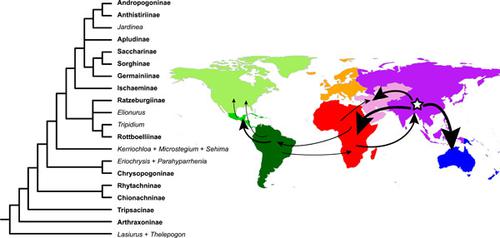当前位置:
X-MOL 学术
›
J. Syst. Evol.
›
论文详情
Our official English website, www.x-mol.net, welcomes your
feedback! (Note: you will need to create a separate account there.)
Phylogenomics enables biogeographic analysis and a new subtribal classification of the Andropogoneae (Poaceae – Panicoideae)
Journal of Systematics and Evolution ( IF 3.4 ) Pub Date : 2020-11-01 , DOI: 10.1111/jse.12691 Cassiano A. D. Welker 1 , Michael R. McKain 2 , Matt C. Estep 3 , Rémy S. Pasquet 4 , Gilson Chipabika 5 , Beatrice Pallangyo 6 , Elizabeth A. Kellogg 7
Journal of Systematics and Evolution ( IF 3.4 ) Pub Date : 2020-11-01 , DOI: 10.1111/jse.12691 Cassiano A. D. Welker 1 , Michael R. McKain 2 , Matt C. Estep 3 , Rémy S. Pasquet 4 , Gilson Chipabika 5 , Beatrice Pallangyo 6 , Elizabeth A. Kellogg 7
Affiliation

|
The grass tribe Andropogoneae (Poaceae—Panicoideae) includes several important crops such as maize, sugarcane, and sorghum, and dominates the tropical grasslands of the world. We present here a plastome phylogeny of the tribe with the largest sample of genera to date (about 73%), including 65 newly assembled plastomes, together with a broad biogeographic analysis of Andropogoneae. Major relationships found in previous phylogenetic studies were confirmed here, with most nodes having higher resolution and support, including those of the backbone of the tree, which had been a major problem in previous phylogenies of the tribe. Our dated tree suggests that Andropogoneae diverged from Arundinelleae in the Early Miocene, while the “core Andropogoneae” clade originated in the Late Miocene. The tribe originated in East Asia, but intercontinental dispersal has been common, with many independent dispersal events to Africa and the New World. Based on the plastome phylogeny, we propose here a new classification of Andropogoneae as most of its previously accepted subtribes are not monophyletic. Our classification comprises 14 subtribes, 92 genera, and ∼1224 species. About 90% of the Andropogoneae species could be assigned to a subtribe, which represents a major step toward clarification of the taxonomy of the tribe. The remaining taxa were placed incertae sedis pending additional molecular data. The new subtribes Chrysopogoninae and Rhytachninae are described herein. Our plastome trees also indicate that several Andropogoneae genera are para‐ or polyphyletic and require additional studies to define their circumscriptions.
中文翻译:

系统基因组学使生物地理学分析成为可能,并且对穿心莲科(禾本科 - Panicoideae)进行了新的亚部落分类
禾本科(禾本科—Panicoideae)包括玉米、甘蔗、高粱等几种重要作物,主宰着世界热带草原。我们在这里展示了该部落的塑性体系统发育史,该部落具有迄今为止最大的属样本(约 73%),包括 65 个新组装的塑性体,以及对穿心莲科的广泛生物地理学分析。在先前的系统发育研究中发现的主要关系在这里得到证实,大多数节点具有更高的分辨率和支持度,包括树的主干,这在部落的先前系统发育中一直是一个主要问题。我们的日期树表明,在早中新世,穿心莲科从 Arundinelleae 分化出来,而“核心穿山甲”分支起源于晚中新世。该部落起源于东亚,但洲际传播很常见,有许多独立的传播事件到非洲和新世界。基于塑性体系统发育,我们在这里提出了一种新的 Andropogoneae 分类,因为其以前接受的大多数亚部落都不是单系的。我们的分类包括 14 个亚部落、92 个属和 ~1224 个物种。大约 90% 的 Andropogoneae 物种可以归入一个亚部落,这代表着向澄清部落分类学迈出的重要一步。剩余的分类群被放置在不确定的 sedis 中,等待额外的分子数据。本文描述了新的亚部落 Chrysopogoninae 和 Rhytachninae。我们的塑性体树还表明,几个穿心莲科属是副系或多系的,需要额外的研究来定义它们的范围。有许多独立的传播活动到非洲和新世界。基于塑性体系统发育,我们在这里提出了一种新的 Andropogoneae 分类,因为其以前接受的大多数亚部落都不是单系的。我们的分类包括 14 个亚部落、92 个属和 ~1224 个物种。大约 90% 的 Andropogoneae 物种可以归入一个亚部落,这代表着向澄清部落分类学迈出的重要一步。剩余的分类群被放置在不确定的 sedis 中,等待额外的分子数据。本文描述了新的亚部落 Chrysopogoninae 和 Rhytachninae。我们的塑性体树还表明,几个穿心莲科属是副系或多系的,需要额外的研究来定义它们的范围。有许多独立的传播活动到非洲和新世界。基于塑性体系统发育,我们在这里提出了一种新的 Andropogoneae 分类,因为其以前接受的大多数亚部落都不是单系的。我们的分类包括 14 个亚部落、92 个属和 ~1224 个物种。大约 90% 的 Andropogoneae 物种可以归入一个亚部落,这代表着向澄清部落分类学迈出的重要一步。剩余的分类群被放置在不确定的 sedis 中,等待额外的分子数据。本文描述了新的亚部落 Chrysopogoninae 和 Rhytachninae。我们的塑性体树还表明,几个穿心莲科属是副系或多系的,需要额外的研究来定义它们的范围。我们在这里提出了一种新的 Andropogoneae 分类,因为它以前被接受的大多数亚部落都不是单系的。我们的分类包括 14 个亚部落、92 个属和 ~1224 个物种。大约 90% 的 Andropogoneae 物种可以归入一个亚部落,这代表着向澄清部落分类学迈出的重要一步。剩余的分类群被放置在不确定的 sedis 中,等待额外的分子数据。本文描述了新的亚部落 Chrysopogoninae 和 Rhytachninae。我们的塑性体树还表明,几个穿心莲科属是副系或多系的,需要额外的研究来定义它们的范围。我们在这里提出了一种新的 Andropogoneae 分类,因为它以前被接受的大多数亚部落都不是单系的。我们的分类包括 14 个亚部落、92 个属和 ~1224 个物种。大约 90% 的 Andropogoneae 物种可以归入一个亚部落,这代表着向澄清部落分类学迈出的重要一步。剩余的分类群被放置在不确定的sedis中,等待额外的分子数据。本文描述了新的亚部落 Chrysopogoninae 和 Rhytachninae。我们的塑性体树还表明,几个穿心莲科属是副系或多系的,需要额外的研究来定义它们的范围。大约 90% 的 Andropogoneae 物种可以归入一个亚部落,这代表着向澄清部落分类学迈出的重要一步。剩余的分类群被放置在不确定的 sedis 中,等待额外的分子数据。本文描述了新的亚部落 Chrysopogoninae 和 Rhytachninae。我们的塑性体树还表明,几个穿心莲科属是副系或多系的,需要额外的研究来定义它们的范围。大约 90% 的 Andropogoneae 物种可以归入一个亚部落,这代表着向澄清部落分类学迈出的重要一步。剩余的分类群被放置在不确定的 sedis 中,等待额外的分子数据。本文描述了新的亚部落 Chrysopogoninae 和 Rhytachninae。我们的塑性体树还表明,几个穿心莲科属是副系或多系的,需要额外的研究来定义它们的范围。
更新日期:2020-11-01
中文翻译:

系统基因组学使生物地理学分析成为可能,并且对穿心莲科(禾本科 - Panicoideae)进行了新的亚部落分类
禾本科(禾本科—Panicoideae)包括玉米、甘蔗、高粱等几种重要作物,主宰着世界热带草原。我们在这里展示了该部落的塑性体系统发育史,该部落具有迄今为止最大的属样本(约 73%),包括 65 个新组装的塑性体,以及对穿心莲科的广泛生物地理学分析。在先前的系统发育研究中发现的主要关系在这里得到证实,大多数节点具有更高的分辨率和支持度,包括树的主干,这在部落的先前系统发育中一直是一个主要问题。我们的日期树表明,在早中新世,穿心莲科从 Arundinelleae 分化出来,而“核心穿山甲”分支起源于晚中新世。该部落起源于东亚,但洲际传播很常见,有许多独立的传播事件到非洲和新世界。基于塑性体系统发育,我们在这里提出了一种新的 Andropogoneae 分类,因为其以前接受的大多数亚部落都不是单系的。我们的分类包括 14 个亚部落、92 个属和 ~1224 个物种。大约 90% 的 Andropogoneae 物种可以归入一个亚部落,这代表着向澄清部落分类学迈出的重要一步。剩余的分类群被放置在不确定的 sedis 中,等待额外的分子数据。本文描述了新的亚部落 Chrysopogoninae 和 Rhytachninae。我们的塑性体树还表明,几个穿心莲科属是副系或多系的,需要额外的研究来定义它们的范围。有许多独立的传播活动到非洲和新世界。基于塑性体系统发育,我们在这里提出了一种新的 Andropogoneae 分类,因为其以前接受的大多数亚部落都不是单系的。我们的分类包括 14 个亚部落、92 个属和 ~1224 个物种。大约 90% 的 Andropogoneae 物种可以归入一个亚部落,这代表着向澄清部落分类学迈出的重要一步。剩余的分类群被放置在不确定的 sedis 中,等待额外的分子数据。本文描述了新的亚部落 Chrysopogoninae 和 Rhytachninae。我们的塑性体树还表明,几个穿心莲科属是副系或多系的,需要额外的研究来定义它们的范围。有许多独立的传播活动到非洲和新世界。基于塑性体系统发育,我们在这里提出了一种新的 Andropogoneae 分类,因为其以前接受的大多数亚部落都不是单系的。我们的分类包括 14 个亚部落、92 个属和 ~1224 个物种。大约 90% 的 Andropogoneae 物种可以归入一个亚部落,这代表着向澄清部落分类学迈出的重要一步。剩余的分类群被放置在不确定的 sedis 中,等待额外的分子数据。本文描述了新的亚部落 Chrysopogoninae 和 Rhytachninae。我们的塑性体树还表明,几个穿心莲科属是副系或多系的,需要额外的研究来定义它们的范围。我们在这里提出了一种新的 Andropogoneae 分类,因为它以前被接受的大多数亚部落都不是单系的。我们的分类包括 14 个亚部落、92 个属和 ~1224 个物种。大约 90% 的 Andropogoneae 物种可以归入一个亚部落,这代表着向澄清部落分类学迈出的重要一步。剩余的分类群被放置在不确定的 sedis 中,等待额外的分子数据。本文描述了新的亚部落 Chrysopogoninae 和 Rhytachninae。我们的塑性体树还表明,几个穿心莲科属是副系或多系的,需要额外的研究来定义它们的范围。我们在这里提出了一种新的 Andropogoneae 分类,因为它以前被接受的大多数亚部落都不是单系的。我们的分类包括 14 个亚部落、92 个属和 ~1224 个物种。大约 90% 的 Andropogoneae 物种可以归入一个亚部落,这代表着向澄清部落分类学迈出的重要一步。剩余的分类群被放置在不确定的sedis中,等待额外的分子数据。本文描述了新的亚部落 Chrysopogoninae 和 Rhytachninae。我们的塑性体树还表明,几个穿心莲科属是副系或多系的,需要额外的研究来定义它们的范围。大约 90% 的 Andropogoneae 物种可以归入一个亚部落,这代表着向澄清部落分类学迈出的重要一步。剩余的分类群被放置在不确定的 sedis 中,等待额外的分子数据。本文描述了新的亚部落 Chrysopogoninae 和 Rhytachninae。我们的塑性体树还表明,几个穿心莲科属是副系或多系的,需要额外的研究来定义它们的范围。大约 90% 的 Andropogoneae 物种可以归入一个亚部落,这代表着向澄清部落分类学迈出的重要一步。剩余的分类群被放置在不确定的 sedis 中,等待额外的分子数据。本文描述了新的亚部落 Chrysopogoninae 和 Rhytachninae。我们的塑性体树还表明,几个穿心莲科属是副系或多系的,需要额外的研究来定义它们的范围。











































 京公网安备 11010802027423号
京公网安备 11010802027423号